本人结合其他博客和自己查询的资料,一步一步实现整合了security安全框架,其中踩过不少的坑,也有遇到许多不懂的地方,为此做个记录。
开发工具:ide、数据库:mysql5.7、springboot版本:2.3.7
个人对Spring Security的执行过程大致理解(仅供参考)
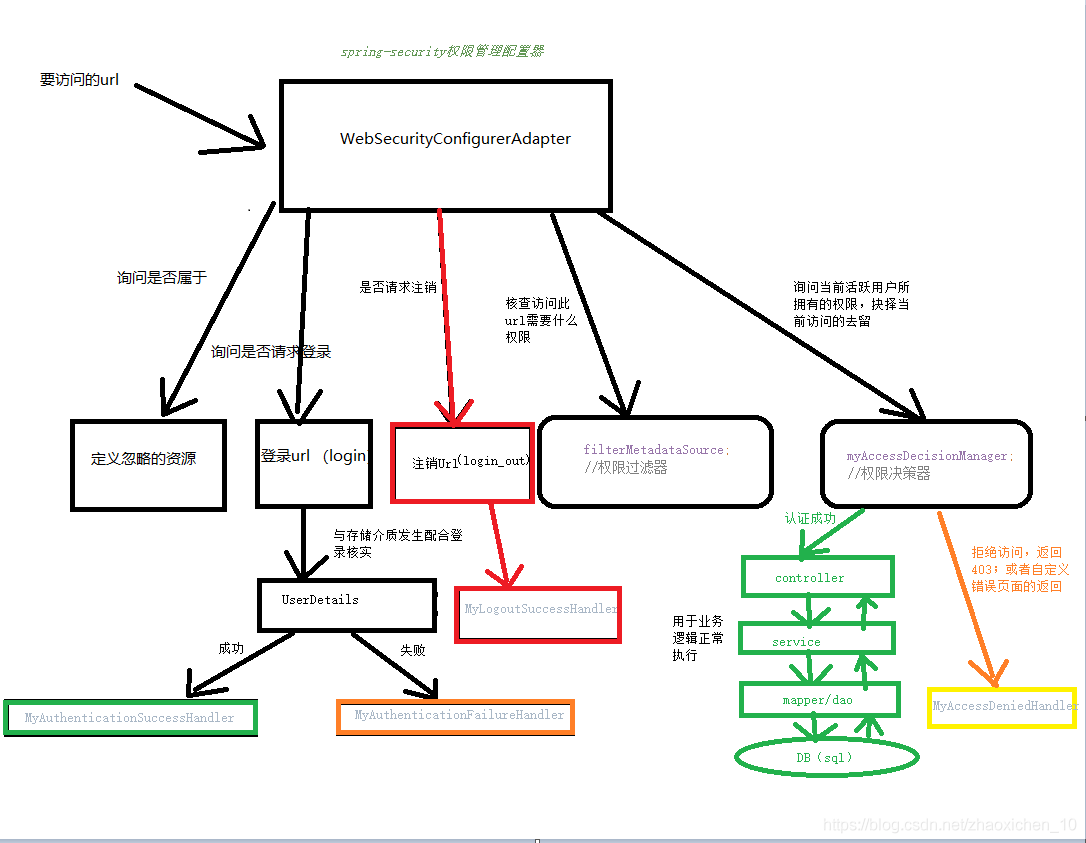
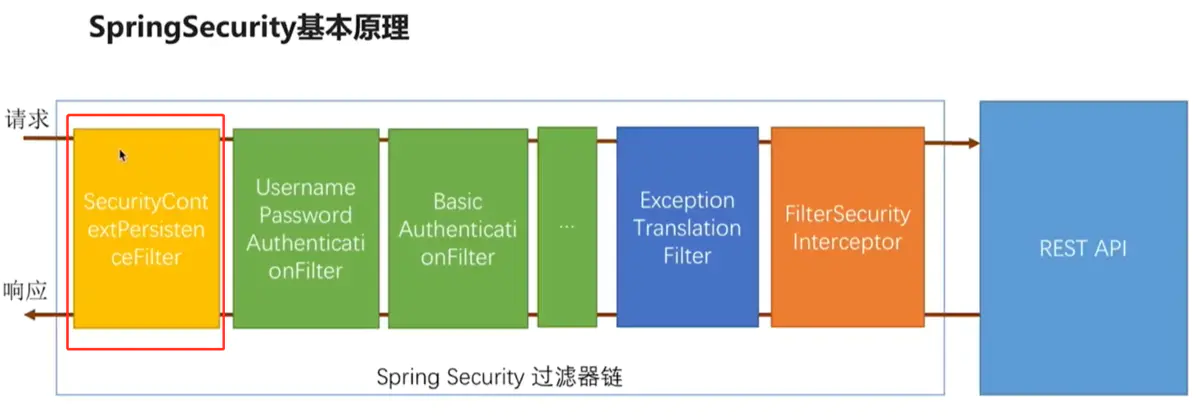
使用Spring Security很简单,只要在pom.xml文件中,引入spring security的依赖就可以了
pom配置:
<dependency> <groupId>org.springframework.boot</groupId> <artifactId>spring-boot-starter-security</artifactId> </dependency>
这个时候我们不在配置文件中做任何配置,随便写一个Controller
@RestController public class TestController { @GetMapping("/hello") public String request() { return "hello"; } }
启动项目,我们会发现有这么一段日志

此时表示Security生效,默认对项目进行了保护,我们访问该Controller中的接口(http://localhost:8080/securitydemo/hello),会见到如下登录界面(此界面为security框架自带的默认登录界面,后期不用可以换成自定义登录界面)
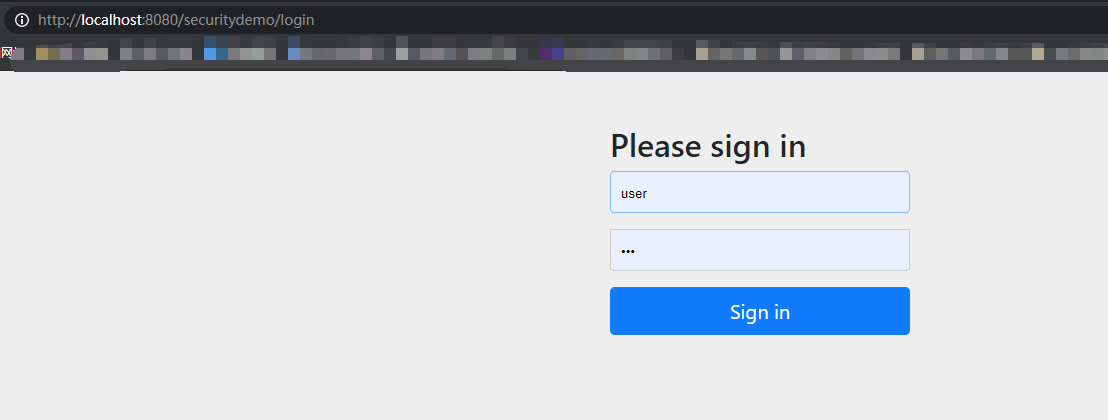
这里面的用户名和密码是什么呢?此时我们需要输入用户名:user,密码则为之前日志中的"19262f35-9ded-49c2-a8f6-5431536cc50c",输入之后,我们可以看到此时可以正常访问该接口

在老版本的Springboot中(比如说Springboot 1.x版本中),可以通过如下方式来关闭Spring Security的生效,但是现在Springboot 2中已经不再支持
security:
basic:
enabled: false
springboot2.x后可以在启动类中设置

1、配置基于内存的角色授权和认证信息
1.1目录
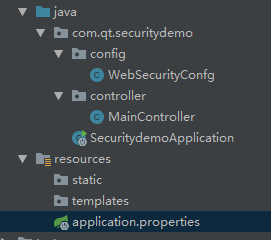
1.2 WebSecurityConfg配置类
Spring Security的核心配置类是 WebSecurityConfigurerAdapter抽象类,这是权限管理启动的入口,这里我们自定义一个实现类去它。
/** * @Author qt * @Date 2021/3/25 * @Description SpringSecurity安全框架配置 */ @Configuration @EnableWebSecurity//开启Spring Security的功能 //prePostEnabled属性决定Spring Security在接口前注解是否可用@PreAuthorize,@PostAuthorize等注解,设置为true,会拦截加了这些注解的接口 @EnableGlobalMethodSecurity(prePostEnabled=true) public class WebSecurityConfg extends WebSecurityConfigurerAdapter { @Override protected void configure(AuthenticationManagerBuilder auth) throws Exception { /** * 基于内存的方式,创建两个用户admin/123456,user/123456 * */ auth.inMemoryAuthentication() .withUser("admin")//用户名 .password(passwordEncoder().encode("123456"))//密码 .roles("ADMIN");//角色 auth.inMemoryAuthentication() .withUser("user")//用户名 .password(passwordEncoder().encode("123456"))//密码 .roles("USER");//角色 } /** * 指定加密方式 */ @Bean public PasswordEncoder passwordEncoder(){ // 使用BCrypt加密密码 return new BCryptPasswordEncoder(); } }
1.3 MainController控制器接口
/** * @Author qt * @Date 2021/3/25 * @Description 主控制器 */ @RestController public class MainController { @GetMapping("/hello") public String printStr(){ System.out.println("hello success"); return "Hello success!"; } }
这样重新运行后我们就可以通过admin/123456、user/123456两个用户登录了。
当然,你也可以基于配置文件创建用户账号,在pom.xml中添加:

2、配置基于数据库的认证信息和角色授权
2.1 目录
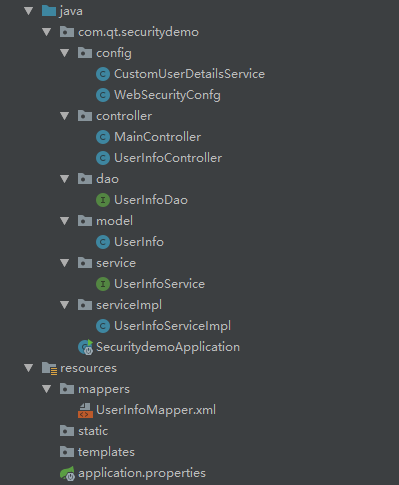
2.2 CustomUserDetailsService实现类
UserDetailsService是需要实现的登录用户查询的service接口,实现loadUserByUsername()方法,这里我们自定义CustomUserDetailsService实现类去实现UserDetailsService接口
/** * @Author qt * @Date 2021/3/25 * @Description */ @Component public class CustomUserDetailsService implements UserDetailsService { @Resource private UserInfoService userInfoService; @Resource private PasswordEncoder passwordEncoder; @Override public UserDetails loadUserByUsername(String userName) throws UsernameNotFoundException { /** * 1/通过userName 获取到userInfo信息 * 2/通过User(UserDetails)返回details。 */ //通过userName获取用户信息 UserInfo userInfo = userInfoService.getUserInfoByUsername(userName); if(userInfo == null) { throw new UsernameNotFoundException("not found"); } //定义权限列表. List<GrantedAuthority> authorities = new ArrayList<>(); // 用户可以访问的资源名称(或者说用户所拥有的权限) 注意:必须"ROLE_"开头 authorities.add(new SimpleGrantedAuthority("ROLE_"+ userInfo.getRole())); User userDetails = new User(userInfo.getUserName(),passwordEncoder.encode(userInfo.getPassword()),authorities); return userDetails; } }
WebSecurityConfg配置类:
/** * @Author qt * @Date 2021/3/25 * @Description SpringSecurity安全框架配置 */ @Configuration @EnableWebSecurity//开启Spring Security的功能 //prePostEnabled属性决定Spring Security在接口前注解是否可用@PreAuthorize,@PostAuthorize等注解,设置为true,会拦截加了这些注解的接口 @EnableGlobalMethodSecurity(prePostEnabled=true) public class WebSecurityConfg extends WebSecurityConfigurerAdapter { /** * 指定加密方式 */ @Bean public PasswordEncoder passwordEncoder(){ // 使用BCrypt加密密码 return new BCryptPasswordEncoder(); } }
对于通过userName获取用户信息的服务层,持久层和数据库语句就不介绍了,这里使用的是SSM框架,使用mybaits。
2.3 数据库设计

角色表 roles


用户表 user


用户角色关系表 roles_user


3、自定义表单认证登录
3.1 目录
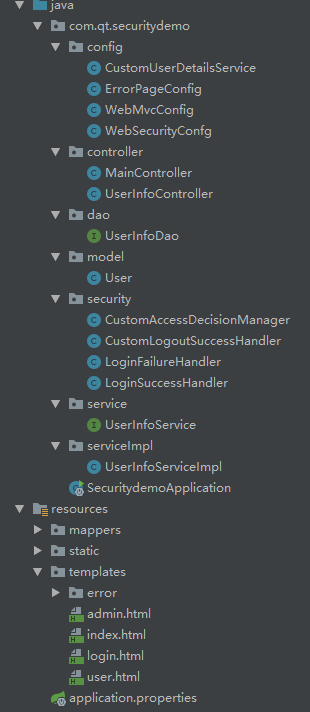
3.2 WebSecurityConfg核心配置类
/** * @Author qt * @Date 2021/3/25 * @Description spring-security权限管理的核心配置 */ @Configuration @EnableWebSecurity//开启Spring Security的功能 //prePostEnabled属性决定Spring Security在接口前注解是否可用@PreAuthorize,@PostAuthorize等注解,设置为true,会拦截加了这些注解的接口 @EnableGlobalMethodSecurity(prePostEnabled=true) public class WebSecurityConfg extends WebSecurityConfigurerAdapter { @Resource private AuthenticationSuccessHandler loginSuccessHandler; //认证成功结果处理器 @Resource private AuthenticationFailureHandler loginFailureHandler; //认证失败结果处理器 //http请求拦截配置 @Override protected void configure(HttpSecurity http) throws Exception { http.headers().frameOptions().disable();//开启运行iframe嵌套页面 http//1、配置权限认证 .authorizeRequests() //配置不拦截路由 .antMatchers("/500").permitAll() .antMatchers("/403").permitAll() .antMatchers("/404").permitAll() .antMatchers("/login").permitAll() .anyRequest() //任何其它请求 .authenticated() //都需要身份认证 .and() //2、登录配置表单认证方式 .formLogin() .loginPage("/login")//自定义登录页面的url .usernameParameter("username")//设置登录账号参数,与表单参数一致 .passwordParameter("password")//设置登录密码参数,与表单参数一致 // 告诉Spring Security在发送指定路径时处理提交的凭证,默认情况下,将用户重定向回用户来自的页面。登录表单form中action的地址,也就是处理认证请求的路径, // 只要保持表单中action和HttpSecurity里配置的loginProcessingUrl一致就可以了,也不用自己去处理,它不会将请求传递给Spring MVC和您的控制器,所以我们就不需要自己再去写一个/user/login的控制器接口了 .loginProcessingUrl("/user/login")//配置默认登录入口 .defaultSuccessUrl("/index")//登录成功后默认的跳转页面路径 .failureUrl("/login?error=true") .successHandler(loginSuccessHandler)//使用自定义的成功结果处理器 .failureHandler(loginFailureHandler)//使用自定义失败的结果处理器 .and() //3、注销 .logout() .logoutUrl("/logout") .logoutSuccessHandler(new CustomLogoutSuccessHandler()) .permitAll() .and() //4、session管理 .sessionManagement() .invalidSessionUrl("/login") //失效后跳转到登陆页面 //单用户登录,如果有一个登录了,同一个用户在其他地方登录将前一个剔除下线 //.maximumSessions(1).expiredSessionStrategy(expiredSessionStrategy()) //单用户登录,如果有一个登录了,同一个用户在其他地方不能登录 //.maximumSessions(1).maxSessionsPreventsLogin(true) ; .and() //5、禁用跨站csrf攻击防御 .csrf() .disable(); } @Override public void configure(WebSecurity web) throws Exception { //配置静态文件不需要认证 web.ignoring().antMatchers("/static/**"); } /** * 指定加密方式 */ @Bean public PasswordEncoder passwordEncoder(){ // 使用BCrypt加密密码 return new BCryptPasswordEncoder(); } }
踩坑点1:登录页面接口/login和登录验证接口/user/login,这里是自己之前一直搞错的重点,这里就用网上的图片展示了
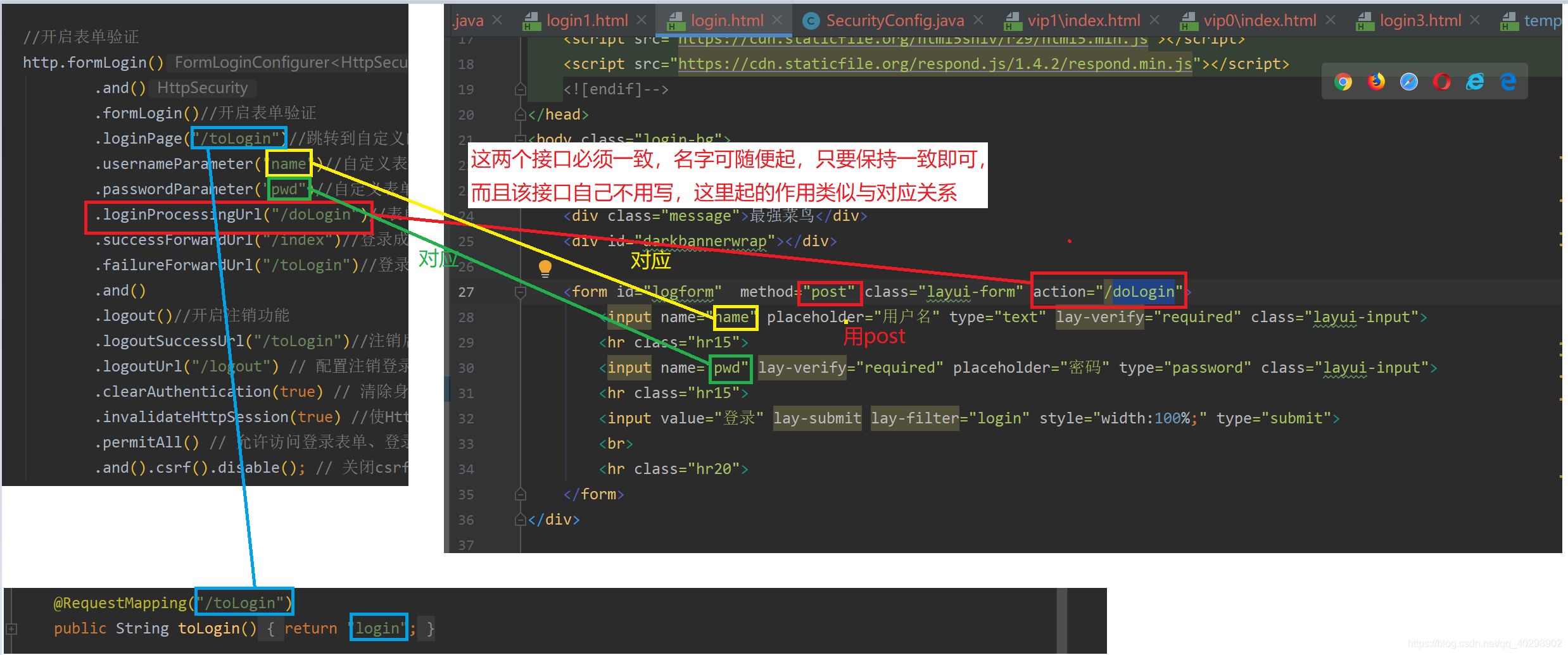
踩坑点2:springboot配置spring security 静态资源不能访问
security的配置:在类WebSecurityConfig继承WebSecurityConfigurerAdapter,这个类是我们在配置security的时候,对我们请求的url及权限规则的一些认证配置。具体的不说了,这里主要是静态资源的问题。
在这个类中我们会重写一些方法,其中就有一个方法,可以为我们配置一下静态资源不需要认证。
@Override public void configure(WebSecurity web) throws Exception { //配置静态文件不需要认证 web.ignoring().antMatchers("/static/**"); }
页面的引用如下:
<link rel="stylesheet" th:href="@{static/layui/css/layui.css}">
之后我们启动项目:看到css并没有生效

这时候仅仅通过spring security配置是不够的,我们还需要去重写addResourceHandlers方法去映射下静态资源,这个方法应该很熟悉了,我们通过springboot添加拦截器的时候就会用到这个。
写一个类WebMvcConfig继承WebMvcConfigurationSupport,注意spring boot2版本和1版本是不一样的,spring boot1版本继承的WebMvcConfigurerAdapter在spring boot2版本中已经提示过时了
@Configuration public class WebMvcConfig extends WebMvcConfigurationSupport { /** * 配置静态资源 * @param registry */ @Override protected void addResourceHandlers(ResourceHandlerRegistry registry) { registry.addResourceHandler("/static/**").addResourceLocations("classpath:/static/"); super.addResourceHandlers(registry); } }
现在重新启动项目:css文件已经引用成功。
3.3 ErrorPageConfig 配置错误页面
/** * @Author qt * @Date 2021/3/25 * @Description 配置错误页面 403 404 500 适用于 SpringBoot 2.x */ @Configuration public class ErrorPageConfig { @Bean public WebServerFactoryCustomizer<ConfigurableWebServerFactory> webServerFactoryCustomizer() { WebServerFactoryCustomizer<ConfigurableWebServerFactory> webCustomizer = new WebServerFactoryCustomizer<ConfigurableWebServerFactory>() { @Override public void customize(ConfigurableWebServerFactory factory) { ErrorPage[] errorPages = new ErrorPage[] { new ErrorPage(HttpStatus.FORBIDDEN, "/403"), new ErrorPage(HttpStatus.NOT_FOUND, "/404"), new ErrorPage(HttpStatus.INTERNAL_SERVER_ERROR, "/500"), }; factory.addErrorPages(errorPages); } }; return webCustomizer; } }
3.4 MainController 控制器
/** * @Author qt * @Date 2021/3/25 * @Description 主控制器 */ @Controller public class MainController { private Logger logger = LoggerFactory.getLogger(getClass()); @GetMapping("/login") public String loginPage(){ System.out.println("login page"); return "login"; } @GetMapping("/index") @PreAuthorize("hasAnyRole('USER','ADMIN')") public String index(){ System.out.println("index page"); return "index"; } @GetMapping("/admin") @PreAuthorize("hasAnyRole('ADMIN')") public String printAdmin(){ System.out.println("hello admin"); return "admin"; } @GetMapping("/user") @PreAuthorize("hasAnyRole('USER','ADMIN')") public String printUser(){ System.out.println("hello user"); return "user"; } /** * 找不到页面 */ @GetMapping("/404") public String notFoundPage() { return "/error/404"; } /** * 未授权 */ @GetMapping("/403") public String accessError() { return "/error/403"; } /** * 服务器错误 */ @GetMapping("/500") public String internalError() { return "/error/500"; } }
3.5 UserInfoController 用户控制器
/** * @Author qt * @Date 2021/3/25 * @Description */ @Controller @RequestMapping("/user") public class UserInfoController { private Logger logger = LoggerFactory.getLogger(getClass()); @Resource private UserInfoService userInfoService; @GetMapping("/getUserInfo") @ResponseBody public User getUserInfo(@RequestParam String username){ return userInfoService.getUserInfoByUsername(username); } }
SMM框架的其他部分就省略了,非这里重点。
3.6 CustomAccessDecisionManager 自定义权限决策管理器
/** * @Author qt * @Date 2021/3/31 * @Description 自定义权限决策管理器 */ @Component public class CustomAccessDecisionManager implements AccessDecisionManager { /** * @Author: qt * @Description: 取当前用户的权限与这次请求的这个url需要的权限作对比,决定是否放行 * auth 包含了当前的用户信息,包括拥有的权限,即之前UserDetailsService登录时候存储的用户对象 * object 就是FilterInvocation对象,可以得到request等web资源。 * configAttributes 是本次访问需要的权限。即上一步的 MyFilterInvocationSecurityMetadataSource 中查询核对得到的权限列表 **/ @Override public void decide(Authentication auth, Object o, Collection<ConfigAttribute> collection) throws AccessDeniedException, InsufficientAuthenticationException { Iterator<ConfigAttribute> iterator = collection.iterator(); while (iterator.hasNext()) { if (auth == null) { throw new AccessDeniedException("当前访问没有权限"); } ConfigAttribute ca = iterator.next(); //当前请求需要的权限 String needRole = ca.getAttribute(); if ("ROLE_LOGIN".equals(needRole)) { if (auth instanceof AnonymousAuthenticationToken) { throw new BadCredentialsException("未登录"); } else return; } //当前用户所具有的权限 Collection<? extends GrantedAuthority> authorities = auth.getAuthorities(); for (GrantedAuthority authority : authorities) { if (authority.getAuthority().equals(needRole)) { return; } } } throw new AccessDeniedException("权限不足!"); } @Override public boolean supports(ConfigAttribute configAttribute) { return true; } @Override public boolean supports(Class<?> aClass) { return true; } }
3.7 CustomLogoutSuccessHandler 注销登录处理
/** * @Author qt * @Date 2021/3/31 * @Description 注销登录处理 */ public class CustomLogoutSuccessHandler implements LogoutSuccessHandler { private Logger logger = LoggerFactory.getLogger(getClass()); @Override public void onLogoutSuccess(HttpServletRequest httpServletRequest, HttpServletResponse response, Authentication authentication) throws IOException, ServletException { System.out.println("注销成功!"); //这里写你登录成功后的逻辑 response.setStatus(HttpStatus.OK.value()); response.setContentType("application/json;charset=UTF-8"); response.getWriter().write("注销成功!"); } }
3.8 LoginFailureHandler 登录失败处理
/** * @Author qt * @Date 2021/3/24 * @Description 登录失败处理 */ @Component("loginFailureHandler") public class LoginFailureHandler extends SimpleUrlAuthenticationFailureHandler { private Logger logger = LoggerFactory.getLogger(getClass()); @Resource private ObjectMapper objectMapper; @Override public void onAuthenticationFailure(HttpServletRequest request, HttpServletResponse response, AuthenticationException exception) throws IOException, ServletException { logger.info("登录失败"); this.saveException(request, exception); this.getRedirectStrategy().sendRedirect(request, response, "/login?error=true"); } }
3.9 LoginSuccessHandler 登录成功处理
/** @Author qt
* @Date 2021/3/24 * @Description 登录成功处理 */ @Component("loginSuccessHandler") public class LoginSuccessHandler extends SavedRequestAwareAuthenticationSuccessHandler { private Logger logger = LoggerFactory.getLogger(getClass()); @Resource private ObjectMapper objectMapper; private RequestCache requestCache; @Override public void onAuthenticationSuccess(HttpServletRequest request, HttpServletResponse response, Authentication authentication) throws ServletException, IOException { // 获取前端传到后端的全部参数 Enumeration enu = request.getParameterNames(); while (enu.hasMoreElements()) { String paraName = (String) enu.nextElement(); System.out.println("参数- " + paraName + " : " + request.getParameter(paraName)); } logger.info("登录认证成功"); //这里写你登录成功后的逻辑,可以验证其他信息,如验证码等。
response.setContentType("application/json;charset=UTF-8"); JSONObject resultObj = new JSONObject(); resultObj.put("code", HttpStatus.OK.value()); resultObj.put("msg","登录成功"); resultObj.put("authentication",objectMapper.writeValueAsString(authentication)); response.getWriter().write(resultObj.toString()); this.getRedirectStrategy().sendRedirect(request, response, "/index");//重定向 } }
3.10 login.html 登录页面
<!DOCTYPE html> <html lang="en" xmlns:th="http://www.thymeleaf.org"> <head> <meta charset="UTF-8"> <title>登录</title> <link rel="stylesheet" type="text/css" th:href="@{static/layui/css/layui.css}"> </head> <body> <form method="POST" th:action="@{/user/login}"> <div> 用户名:<input type="text" name="username" id="username"> </div> <div> 密码:<input type="password" name="password" id="password"> </div> <div> <button type="submit">立即登陆</button> </div> <!-- 以下为显示认证失败等提示信息(th:if=""一定要写 )--> <span style="color: red;" th:if="${param.error}" th:text="${session.SPRING_SECURITY_LAST_EXCEPTION.message}"></span> </form> </body> </html>
3.11 效果图片
登录失败

登录成功

4、自定义ajax请求认证登录
本人比较喜欢使用ajax的登录认证方式,这个比较灵活。
4.1 目录
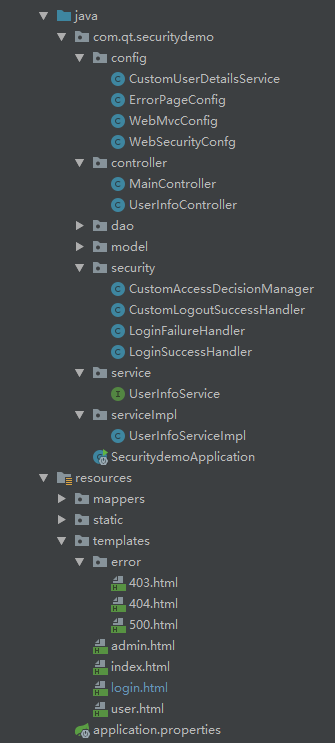
4.2、较表单登录认证的改变
LoginFailureHandler 登录失败处理
/** * @Author qt * @Date 2021/3/24 * @Description 登录失败处理 */ @Component("loginFailureHandler") public class LoginFailureHandler extends SimpleUrlAuthenticationFailureHandler { private Logger logger = LoggerFactory.getLogger(getClass()); @Resource private ObjectMapper objectMapper; @Override public void onAuthenticationFailure(HttpServletRequest request, HttpServletResponse response, AuthenticationException exception) throws IOException, ServletException { logger.info("登录失败"); response.setContentType("application/json;charset=UTF-8"); //这里写你登录失败后的逻辑,可加验证码验证等 String errorInfo = ""; if (exception instanceof BadCredentialsException || exception instanceof UsernameNotFoundException) { errorInfo = "账户名或者密码输入错误!"; } else if (exception instanceof LockedException) { errorInfo = "账户被锁定,请联系管理员!"; } else if (exception instanceof CredentialsExpiredException) { errorInfo = "密码过期,请联系管理员!"; } else if (exception instanceof AccountExpiredException) { errorInfo = "账户过期,请联系管理员!"; } else if (exception instanceof DisabledException) { errorInfo = "账户被禁用,请联系管理员!"; } else { errorInfo = "登录失败!"; } logger.info("登录失败原因:" + errorInfo); //ajax请求认证方式 JSONObject resultObj = new JSONObject(); resultObj.put("code", HttpStatus.UNAUTHORIZED.value()); resultObj.put("msg",errorInfo); resultObj.put("exception",objectMapper.writeValueAsString(exception)); response.getWriter().write(resultObj.toString()); //表单认证方式 //this.saveException(request, exception); //this.getRedirectStrategy().sendRedirect(request, response, "/login?error=true"); } }
LoginSuccessHandler 登录成功处理
/** * @Author qt * @Date 2021/3/24 * @Description 登录成功处理 */ @Component("loginSuccessHandler") public class LoginSuccessHandler extends SavedRequestAwareAuthenticationSuccessHandler { private Logger logger = LoggerFactory.getLogger(getClass()); @Resource private ObjectMapper objectMapper; @Override public void onAuthenticationSuccess(HttpServletRequest request, HttpServletResponse response, Authentication authentication) throws ServletException, IOException { response.setContentType("application/json;charset=UTF-8"); // 获取前端传到后端的全部参数 Enumeration enu = request.getParameterNames(); while (enu.hasMoreElements()) { String paraName = (String) enu.nextElement(); System.out.println("参数- " + paraName + " : " + request.getParameter(paraName)); } logger.info("登录认证成功"); //这里写你登录成功后的逻辑,可加验证码验证等 //ajax请求认证方式 JSONObject resultObj = new JSONObject(); resultObj.put("code", HttpStatus.OK.value()); resultObj.put("msg","登录成功"); resultObj.put("authentication",objectMapper.writeValueAsString(authentication)); response.getWriter().write(resultObj.toString()); //表单认证方式 //this.getRedirectStrategy().sendRedirect(request, response, "/index");//重定向 } }
login.html 登录页面
<!DOCTYPE html> <html lang="en" xmlns:th="http://www.thymeleaf.org"> <head> <meta charset="UTF-8"> <title>登录</title> <link rel="stylesheet" type="text/css" th:href="@{static/layui/css/layui.css}"> </head> <body> <form method="POST" action=""> <div> 用户名:<input type="text" name="username" id="username"> </div> <div> 密码:<input type="password" name="password" id="password"> </div> <div> <input type="button" name="login" id="login" th:value="立即登陆" onclick="mylogin()"> </div> </form> <script type="text/javascript" charset="utf-8" th:src="@{static/jquery/jquery-3.5.1.min.js}"></script> <script type="text/javascript" charset="utf-8" th:src="@{static/layui/layui.js}"></script> <script th:inline="javascript" type="text/javascript"> layui.use(['form','jquery','layedit', 'laydate'], function () { var $ = layui.jquery, form = layui.form, layer = layui.layer; }); function mylogin() { var username = $("#username").val(); var password = $("#password").val(); console.log("username:" + username + "password:" + password); var index = layer.load(1); $.ajax({ type: "POST", dataType: "json", url: "user/login", data: { "username": username, "password": password //可加验证码参数等,后台登陆处理LoginSuccessHandler中会传入这些参数 }, success: function (data) { layer.close(index); console.log("data===>:" + JSON.stringify(data)); if (data.code == 200) { //登录成功 window.location.href = "index"; } else { layer.msg(data.msg, { icon: 2, time: 3000 //2秒关闭(如果不配置,默认是3秒) }); } }, error: function () { layer.close(index); layer.msg("数据请求异常!", { icon: 2, time: 2000 //2秒关闭(如果不配置,默认是3秒) }); } }); } </script> </body> </html>
4.3 演示图片
登录失败

登录成功

最后添加一个我写的一个小demo,里面也整合了security框架,使用springboot + ssm后端框架 + maven依赖包管理 + thmeleaf模板引擎 + pear-admin-layui前端框架等。
demo演示地址:http://www.qnto.top/springfashionsys/login
demo只对数据分析页面做了权限设置,只有admin才可访问。
转载需要加链接哦,整理不易。
总结:实践是检验真理的唯一标准,亲测可用。
参考链接:
https://blog.csdn.net/qq_40298902/article/details/106433192
https://www.e-learn.cn/topic/3143567
https://blog.csdn.net/qq_20108595/article/details/89647419
http://www.spring4all.com/article/428
https://blog.csdn.net/tanleijin/article/details/100698486
https://blog.csdn.net/zhaoxichen_10/article/details/88713799
https://blog.csdn.net/hanxiaotongtong/article/details/103095906
https://www.jb51.net/article/140429.htm
https://www.jianshu.com/p/29d10ad22531
https://blog.csdn.net/weixin_39588542/article/details/110507502
https://blog.csdn.net/sinat_33151213/article/details/89931819
文章来源: 博客园
- 还没有人评论,欢迎说说您的想法!





 客服
客服


